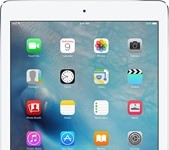
Sony Type G ultra-mobile notebook.
Rumours abound in the Apple world that the manufacturer will produce a subnotebook without an optical drive, and with a LED-based screen either at the end of this year or the start of next. An extra feature that Apple should consider is replacing the hard disk by a Flash drive. Sony has announced a Flash-based subnotebook that will cost 1,900 USD, sport a 32 GB Flash drive (which makes up a large part of the price), and will only weigh 900 grams (slightly less than two pounds). And Dell now ships its Latitude D420 laptops (1300 grams) with a 32 GB Flashdrive instead of a hard disk, if you do so desire.
The major advantage of Flash and LED are that they consume less power, and therefore the batteries will last longer. But for the e-book reader who doesn’t need a dedicated device, an added advantage of Flash may be that it is lighter than a hard disk, and that like an optical disk it can often be removed easily and swapped between devices.
I have known the word “convergence” almost since my earliest computing days, but I have never seen much happen in that arena. Whatever the reason that people keep making and buing PMPs, PDAs, notebooks, subnotebooks, smart phones, UMTPs and so on — and I have never heard people come up with one that explains it all — the fact remains that they do. The e-book afficionado who doesn’t want to go with E Ink (expensive, slow, screen not good enough) will have to look for an alternative device. I am afraid though these new subnotebooks won’t do.
The idea behind sub-notebooks seems to be that they are ultra-mobile, that is to say that they can actually be used “on the road”. This requires laptops that go easy on the juice, are light-weight and so on; many of the qualities that a good e-book reading device should have. But they should also be as fast as possible, with graphics as good as possible, and that will mean that for now they’ll be hot (literally) and expensive.
Still, it’s another category of devices to watch closely the coming months.
One more interesting tidbit: you can now get IDE-to-Flash interfaces for twenty USD or so. My 12 inch iBook has been cowering in a corner since I found that out: how much lighter would it be if I ripped half its innards out and replaced its hard drive and dvd-drive by a Flash disk?


































Great job, Branko. This issue is close to home. You’ll notice that I actually prefer to read e-books on a modest little DT 375 CE machine with solid-state storage rather than an XP machine with a 6G drive. Each to this own. I just don’t like the extra weight, or worrying about the drive. David
A couple years ago David Rothman and I talked with a handheld device expert and another who might help with funding and manufacturing. The idea, originated by David, was to design a basic handheld device optimized for reading digital publications (like e-books) which would have had factory plug-in capability for a variety of vertical markets.
It would have been a full subnotebook computer, running a real OS (e.g., Windows XP and Linux), but would allow the owner to customize it for their particular needs. Need wireless? Put in a wireless plugin. Need audio? Put in a plug-in for that. GPS? One for that, too. Need to add cellphone capability with a headset? You got it. Want a fish locator plug-in? Available for the model marketed to the fishing community. Etc. (Branko’s mention of Flash drives is very interesting for this device.)
This general design allows developing, optimizing, and marketing the base device plus plug-ins for a variety of vertical markets without having to design and manufacture from scratch for each market. The per unit cost for the base would go down a lot as a result (plastic case molding alone is expensive unless amortized over a large number of units!) We could even consider a couple of basic form factors, although that will raise the per unit cost some. (Obviously the base device would have to be developed to be quite rugged — a weatherproof variation needs to be considered in the fundamental design.)
Suffice to say it didn’t get off the ground. To do a credible job we would have needed a minimum of approximately $15 million, and raising such capital is very difficult — we would have had to assemble an experienced team and bring in founders and lead management who’ve successfully completed probjects of this magnitude before — not to mention requiring major marketing.) But it was a useful exercise in what is possible.
(As an aside, it is intriguing to consider an “open source” engineering project to develop the basic electronic and form factor design for this multi-purpose device.)
There are no doubt serious flaws in some of our ideas as described above, but still the factory modular idea is intriguing and at first glance appears to marry the best of the dedicated device with the “convergence” device. (Of course some would say that laptops with PCMCIA cards gives this, but our ideas for plug-ins were more integrated into the electronics and interface of the base unit, thus allowing us to optimize the device at the factory for every vertical market we target.)
Of course, some might even be intrigued with the buffet style of marketing this device, where an individual ordering the unit can get it their way, and we certainly considered that approach.
1. Subnotebooks – its all about battery life, battery life and battery life. Not only do I take my subnotebook everywhere because it weighs next to nothing, but it goes for about 6 hours on a single battery charge.
Yes, its not as high-powered as a 6 pound, 2-hour dual core machine, but for 99% of business-style tasks — web browsing, writing, spreadsheets, etc. even the lowest speed processors long ago passed the point where sheer processor speed, etc. meant much in those areas.
My Dell subnotebook runs World of Warcraft at more-than-acceptable speeds. I wouldn’t try to seriously play a recent FPS on it, but for most other games its perfectly acceptable.
2. Flash drives in subnotebooks
This sounds like a good idea, but OSes and a number of applications create a large # of temp files while running which is not good because most Flash drives will not last long if you are constantly creating large #s of new files. Perhaps they’ve overcome this problem in the drives that Sony and Dell are using.
3. The long-term
Where we’re headed with this is a world where people routinely carry around with them what just a few decades ago would have been considered a staggering amount of data. At some point pretty much every device you carry is going to have 100gb+ of flash storage just because its too cheap not to include.
What I really want in an OLPC-type device: light, low power usage and USB are really all I need, because as long as the OS is built in somehow, I can carry most of my files on a jump drive and pkug it via USB. The OLPC appeals to me because it runs a real OS, I like the tablet idea, and I like the idea of recharging it on the go with a hand crank or foot pedal or somesuch. I think that if someone else comes to market with a sub-$500 ‘computer’ like the OLPC, there would be a huge market. I know the Alphasmart people had a Palm OS-based small and light device, but imho the price point on all of their products has not come around to what the marketplace is like right now. I would not pay almost $400 just for a word processor when I can get a full computer for that.
I think the idea that not everyone needa a full-on hard-core does everything device is an emerging realization in the computer world. My mom for example just wants to type emails and play Bookworm on Yahoo Games. Why does she need a $1000 pc for this? I think the future what we will see is everyone having desktops as their sort of ‘hub’ computer with all their multimedia and file management programs (itunes etc) on there, and then also having small, cheap pda/tablet type devices they travel with—or else, everyone carrying around jump drives with their whole computer on it.
If we ever get OLPC type devices, I see my setup being 1) main computer at home, where I keep my media library, store my files, do my printing, keep my Quicken file or whatever and 2) OLPC-type device where I read ebooks, work on files on the go (and transfer them to my pc for storage/printing etc when I am done) and do internet stuff on the go. I keep all my bookmarks on Foxmarks anyway, and have favourites saved in google. A net box plus word processor and ebook reader would satisfy all my mobile needs, as long as the price was right.
I am fervently hoping for the OLPC to put out a commercial version with all the same features, including the foot pedal or handcrank or whatever. I can think of tons of times I might want to be able to generate my own power. I love the tablet. It is seriously my dream device and I can’t believe they are being so stubborn about exploiting an obvious commercial market for it.
The ultrasmall computers we’re starting to see demonstrate that it isn’t about the size of the components. The reason so many laptops are huge heavy battery-sucking monsters is because people want big screens. (Before you go on about hard drives, remember that Palm offers a PDA with a hard drive. They don’t have to be hot and heavy).
We don’t need a huge screen for book reading but they are useful for graphics programs (I need all the screen I can get when I design book covers), spreadsheets (for when I go looking for the elusive profit), game playing, and movie-watching (when I give up looking for profit).
Ultimately, I think the answer is a display in a headset. In the meantime, I think we’ll all struggle witht the compromises. It is nice, as Branko says, to have a real computer with a real OS.
Rob Preece
Publisher, http://www.BooksForABuck.com
As Rob brought up, the headset display has intrigued me for a number of years — I believe I brought it up on the eBook Community in the late 90s. Using a headset display frees up the design for the rest of the electronics, which can be optimized for wearing/toting, not constrained by having to integrate a flat screen.
Of course, with this architecture one can also envision using a separate flat screen if needed or preferred over a headset device. In either case, the display can be connected by wire and/or connected by wireless (with wireless the display can be some distance from the main electornics.)
Lots of possibilities if one starts to think outside the box.
(Btw, headset displays are intriguing for reasons of power consumption, color gamut (saturation), and use in any type of lighting. They combine the advantages of reflective type screens such as e-Ink (e-Ink’s advantages are low power consumption and use in bright light conditions, but being reflective will likely never have good color gamut) with the advantages of emitting type of displays LCD/OLED/etc. (which can be used in low light but suffer in bright light conditions, and typically have much better color gamut than do reflective displays.)